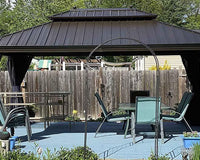Introduction
More than merely rain protection, umbrellas are seasonal friends that cover us from unplanned downpours and strong storms. Many of us toss our umbrellas as the rainy season passes, neglecting their essential maintenance needs. Good off-season maintenance guarantees that your umbrella stays dependable, extending its lifetime and keeping it ready for the next wet season. The necessary steps of umbrella care and preservation will be guided through by this guide.
1. Inspect Your Umbrella After the Season Ends
Finding possible problems compromising the performance of your umbrella depends on a thorough post-season inspection. Start by gently opening the umbrella in a well-lit space and painstakingly reviewing every element. Look closely for small holes, fraying edges, or patches of thinning material that would indicate imminent failure.
Given that your umbrella's structural backbone is the ribs and stretchers, they call particular attention. Test every rib for straightness and flexibility gently to make sure they move without friction. Search metal components for any corrosion, especially at connecting places where moisture could have accumulated over regular use.
Focus especially on the opening mechanism and handle. Check that the slide or button mechanism runs without sticking or needing too much force. Look for any structural weakness or looseness in the handle-to-umbrella shaft that might affect the integrity of the umbrella.

2. Clean Umbrella Properly Before Storage
Cleaning your umbrella thoroughly prevents potential damage and ensures it's ready for future use. Different fabric types require specific cleaning approaches. For nylon and polyester umbrellas, prepare a mild cleaning solution using gentle detergent and lukewarm water. Avoid harsh chemicals that might degrade the fabric's water-resistant properties.
Use a soft cloth or sponge to gently clean the entire surface, paying extra attention to areas with visible dirt or stains. For stubborn marks, create a solution of water and white vinegar, which effectively removes grime without damaging the fabric. Carefully clean both the interior and exterior surfaces, ensuring you remove all debris and potential mold spores.
The umbrella's frame requires careful cleaning as well. Use a soft, slightly damp cloth to wipe down metal components, removing any salt residue or accumulated dust. For wooden handles, use a specialized wood cleaner that preserves the material's natural finish. Always be gentle to prevent inadvertently causing damage during the cleaning process.

3. Dry Your Umbrella
Proper drying is critical to preventing corrosion and fabric degradation. After cleaning, open the umbrella completely and place it in a well-ventilated area away from direct sunlight. Hanging the umbrella allows air to circulate freely, ensuring thorough drying of both fabric and metal components.
Avoid using artificial heat sources like hair dryers or radiators, as these can damage the umbrella's delicate materials. Excessive heat might cause the fabric to shrink or become brittle, compromising its water-resistant properties. Instead, choose a naturally warm, dry location with good air circulation.
Pay special attention to hidden moisture points. Gently shake the umbrella to remove excess water, and use a clean, soft towel to blot away any remaining moisture. Allow several hours of drying time, ensuring every part of the umbrella is completely dry before storage.
4. Provide Ideal Storage Conditions for Umbrellas
Maintaining the state of your umbrella over the off-season depends mostly on storage. Find a cool, dry place with minimal humidity and constant temperature. Store umbrellas in dry and cool places; severe climatic conditions can cause material degradation.
To guard the umbrella from dust and possible damage, think about covering or bagging it.
Store the umbrella erect if at all possible to help it to retain its original form. The ribs and stretcher mechanism may be irreparably damaged if you compress or bend the umbrella.
Apply a thin layer of silicone spray or light machine oil to guard metal components from possible rust. This stops oxidation over long-term storage and forms a barrier against moisture. To stop any inadvertent damage or scratching, wrap the handle with a soft towel.

5. Repair Minor Damages
Minor umbrella damages can often be repaired at home with basic tools and a bit of patience. Bent ribs can typically be carefully straightened using pliers, applying gentle, even pressure to restore their original shape. For small tears in the canopy, use specialized fabric repair tape designed for waterproof materials.
Broken handles might require more specialized attention. Some can be reattached using strong epoxy designed for multiple materials. Examine the break carefully, ensuring clean edges and proper alignment before applying any adhesive. For complex repairs, consider consulting a professional umbrella repair service.
Elastic cord replacements are relatively simple for those comfortable with basic sewing. Purchase replacement elastic that matches the original thickness, carefully removing the old cord and threading the new one through the umbrella's mechanism. Take your time and work methodically to ensure proper installation.
6. Try Some Creative Umbrella Repurposing Ideas
Old umbrellas offer numerous creative opportunities beyond their original purpose. Transform a damaged umbrella into a unique garden art piece by removing the fabric and using the frame as a decorative structure for climbing plants. The intricate metal design can create an interesting architectural element in your garden.
Craft enthusiasts can deconstruct umbrellas to create innovative home decor. The waterproof fabric works excellently for creating outdoor cushion covers, protective garden furniture covers, or even unique tote bags. The umbrella's ribs can be repurposed into wind chimes or sculptural wall art.
Consider donating functional umbrellas to local shelters or community organizations. Some schools and art programs also appreciate umbrella donations for creative projects. By finding new purposes for old umbrellas, you reduce waste and potentially help others while giving your trusty rain companion a second life.

Conclusion
Good umbrella care is an investment in lifespan as much as usefulness. Using these meticulous storage and preservation methods will help you to make sure your umbrella stays a dependable friend over several wet seasons. Protecting your umbrella and getting it ready for next usage depends much on small off-season maintenance.




